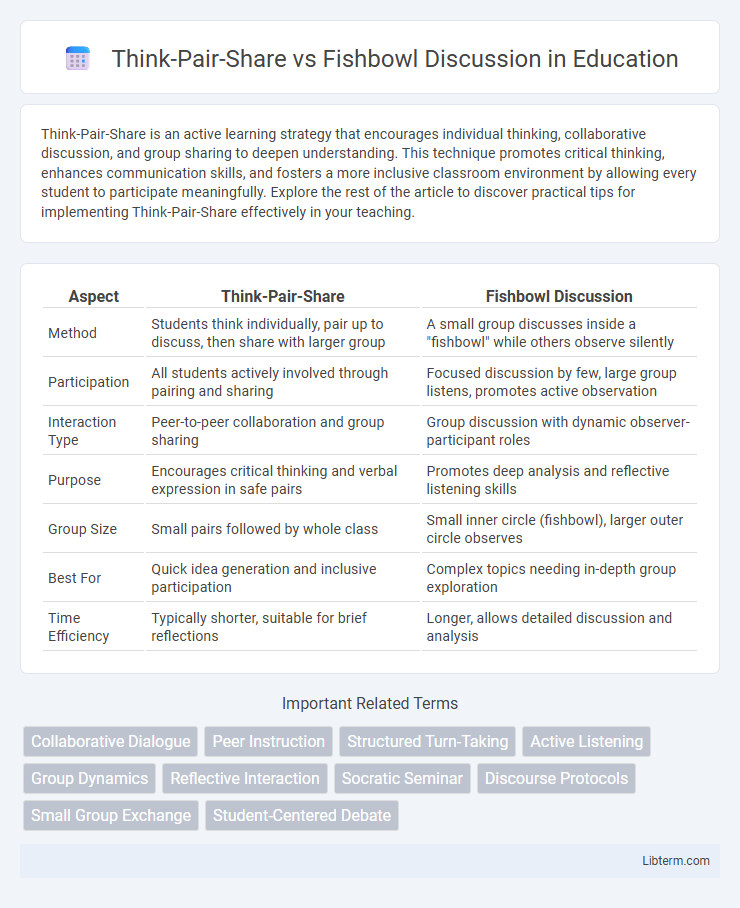Think-Pair-Share is an active learning strategy that encourages individual thinking, collaborative discussion, and group sharing to deepen understanding. This technique promotes critical thinking, enhances communication skills, and fosters a more inclusive classroom environment by allowing every student to participate meaningfully. Explore the rest of the article to discover practical tips for implementing Think-Pair-Share effectively in your teaching.
Table of Comparison
| Aspect | Think-Pair-Share | Fishbowl Discussion |
|---|---|---|
| Method | Students think individually, pair up to discuss, then share with larger group | A small group discusses inside a "fishbowl" while others observe silently |
| Participation | All students actively involved through pairing and sharing | Focused discussion by few, large group listens, promotes active observation |
| Interaction Type | Peer-to-peer collaboration and group sharing | Group discussion with dynamic observer-participant roles |
| Purpose | Encourages critical thinking and verbal expression in safe pairs | Promotes deep analysis and reflective listening skills |
| Group Size | Small pairs followed by whole class | Small inner circle (fishbowl), larger outer circle observes |
| Best For | Quick idea generation and inclusive participation | Complex topics needing in-depth group exploration |
| Time Efficiency | Typically shorter, suitable for brief reflections | Longer, allows detailed discussion and analysis |
Introduction to Collaborative Learning Strategies
Think-Pair-Share and Fishbowl Discussion are effective collaborative learning strategies that enhance student engagement and critical thinking. Think-Pair-Share promotes individual accountability by encouraging students to first reflect independently, then discuss ideas with a partner, fostering deeper understanding through peer interaction. Fishbowl Discussion allows a smaller group to engage in dialogue while others observe, promoting active listening and diverse perspective sharing within a structured format.
Overview of Think-Pair-Share
Think-Pair-Share is an interactive teaching strategy designed to promote student engagement and enhance critical thinking by structuring conversations in three phases: thinking individually, discussing with a partner, and sharing with the larger group. This method encourages active participation and allows students to develop and articulate their ideas in a supportive setting before presenting to peers. Educators often use Think-Pair-Share to increase classroom interaction and improve comprehension across diverse subjects.
Overview of Fishbowl Discussion
Fishbowl Discussion is a collaborative teaching strategy where a small group of participants sits in an inner circle discussing a topic while the larger group observes from the outer circle, fostering active listening and reflective thinking. This format encourages dynamic interaction, enabling observers to gain diverse perspectives before joining the discussion by switching seats. Fishbowl Discussions enhance critical thinking and promote inclusive participation, making it effective for exploring complex issues in educational and professional settings.
Key Objectives of Each Method
Think-Pair-Share enhances individual accountability and active participation by encouraging students to first reflect independently, then collaborate with a partner, promoting deeper understanding through peer interaction. Fishbowl Discussion focuses on developing critical thinking and communication skills by having a small group engage in dialogue while others observe, fostering reflective listening and comprehensive group analysis. Both methods prioritize engagement and collaborative learning, but Think-Pair-Share emphasizes quick peer feedback, whereas Fishbowl supports structured, deliberative discussions.
Classroom Implementation: Step-by-Step
Think-Pair-Share begins with presenting a question or problem to students, followed by individual thinking time, then pairing to discuss responses before sharing with the larger class, facilitating active engagement and peer learning. Fishbowl Discussion implements by arranging a small inner circle of students to discuss a topic while the outer circle observes, then rotating roles to allow all students to participate actively and reflect on differing perspectives. Both strategies require clear instructions, purposeful question design, and structured reflection phases to maximize classroom interaction and deepen understanding.
Benefits of Think-Pair-Share
Think-Pair-Share enhances student engagement by encouraging individual thinking followed by collaborative dialogue, which deepens comprehension and critical thinking skills. This strategy promotes active participation from all students, including those who may be hesitant to speak in larger groups, thus fostering inclusivity. Research shows that Think-Pair-Share improves retention and allows immediate feedback, leading to better learning outcomes compared to more passive discussion methods like Fishbowl Discussion.
Advantages of Fishbowl Discussion
Fishbowl Discussion fosters dynamic participation by allowing a small group to discuss while others observe, promoting active listening and diverse perspectives. This method encourages deeper engagement and critical thinking, as participants rotate roles between observer and contributor. Fishbowl Discussions also enhance inclusivity by giving quieter students a structured space to voice their ideas without the dominance often seen in whole-class debates.
Challenges and Limitations
Think-Pair-Share poses challenges such as limited depth of discussion due to its brief pairing time and potential unequal participation within pairs. Fishbowl Discussion faces limitations including logistical constraints with group size and difficulties ensuring that all participants engage meaningfully, especially those outside the inner circle. Both methods can struggle with maintaining focus and managing dominant voices, impacting the quality of collaborative learning.
Choosing the Best Method for Your Classroom
When selecting between Think-Pair-Share and Fishbowl Discussion, consider class size and engagement goals; Think-Pair-Share suits larger groups by promoting individual reflection followed by peer interaction, while Fishbowl Discussion enhances active listening and deeper analysis in smaller settings. The complexity of the topic and desired depth of conversation may also influence the choice, as Fishbowl fosters open dialogue among a visible inner circle with observers, encouraging diverse perspectives. Effective implementation depends on aligning these methods with learning objectives, classroom dynamics, and student participation levels to maximize critical thinking and collaboration.
Conclusion: Enhancing Student Engagement
Think-Pair-Share boosts student engagement by promoting individual accountability and active participation through structured peer interaction. Fishbowl Discussion enhances engagement by enabling dynamic group dialogue and deep listening skills, fostering critical thinking in a visible and collaborative environment. Combining both methods can create a balanced approach that maximizes student involvement and enriches classroom discourse.
Think-Pair-Share Infographic

 libterm.com
libterm.com